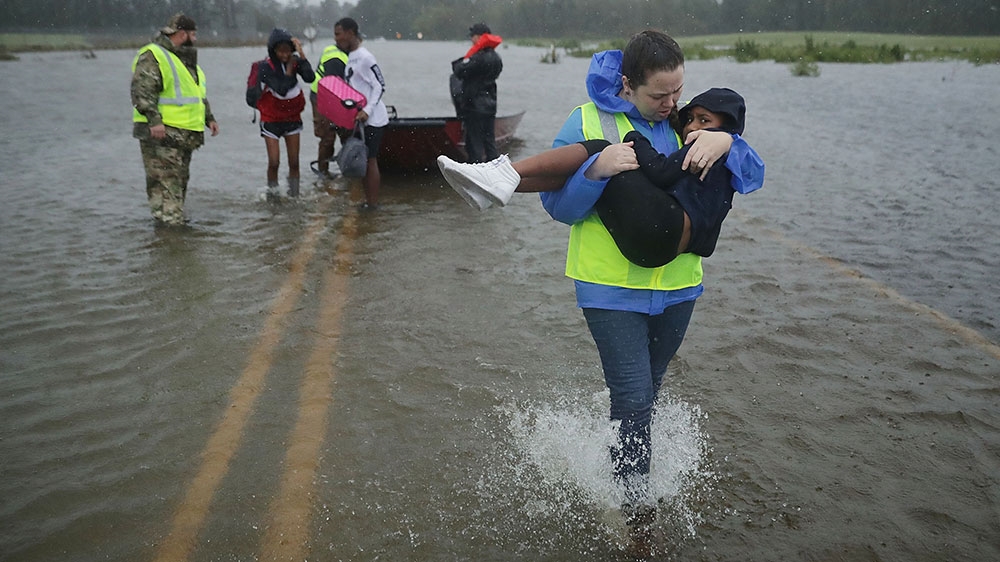SOURCE: Al Jazeera and news agencies

Florence continues to dump rain and threaten lives on the east coast of the US even after it was downgraded from a hurricane to a tropical storm after making landfall.
The National Hurricane Center (NHS) said on Saturday that Florence will produce top winds of 80kmh and is “dumping” almost 40cm of additional rain on US states North and South Carolina.
The number of dead rose to at least seven by early Saturday, authorities said. Five people were known to have perished on Friday, including a mother and infant in North Carolina who died after a tree fell on their home.
The reports came after Florence made landfall as a Category 1 hurricane at 7:15am local time (11:30 GMT) at Wrightsville Beach, a few miles east of Wilmington, as the centre of its eye moved onshore, the National Hurricane Center (NHS) said.
By 4:50pm (20:50GMT) on Friday, NHS had downgraded the hurricane to a tropical storm, but Florence’s movement had slowed to a crawl, piling on the rain in a siege that could go on all weekend long.
WPD can confirm the first two fatalities of Hurricane #Florence in Wilmington. A mother and infant were killed when a tree fell on their house. The father was transported to NHRMC with injuries. https://t.co/FC5PAhuxig
— Wilmington Police (@WilmingtonPD) September 14, 2018
“It’s an uninvited brute who doesn’t want to leave,” said North Carolina Governor Roy Cooper on Friday. He said parts of his state had seen storm surges as high as 10 feet, adding that the storm was “wreaking havoc” and could wipe out entire communities as it makes its “violent grind across our state for days”.
Florence caused widespread damage and knocked out power for nearly one million people.
Underwater for ‘a week or more’
Meteorologists said flooding was expected along waterways far from the coast of North and South Carolina and possibly other states.
AccuWeather, a US-based weather service, said that some communities might be under flood water for “possibly a week or more.”
Florence’s centre was about 75km west-southwest of Wilmington, North Carolina, and about 45km northeast of Myrtle Beach, South Carolina, according to the NHS.
 |
| The Neuse River floods the waterfront in New Bern, North Carolina, on September 14, 2018 during Hurricane Florence [Logan Cyrus/AFP] |
Meteorologists have noted that Florence’s strange, stationary behaviour allows it to take in moisture from the ocean for continued downpours.
Though winds have since settled, a gust of 169km/h was recorded at Wilmington airport on Friday, surpassing the power of Hurricane Fran two decades ago.
 |
| Rescuers search a flooded neighbourhood in Fairfield Habour, North Carolina for evacuees during Hurricane Florence [Chip Somodevilla/Getty Images/AFP] |
The NHS also said a gauge north of Wilmington in Emerald Isle, North Carolina, reported 1.92 metres of rainfall.
Evacuations
Officials said some 1.7 million people in the Carolinas and Virginia were warned to evacuate, but it’s unclear how many did. The homes of about 10 million were under watches or warnings for the hurricane or tropical storm conditions. Coastal towns in the Carolinas were largely empty, and schools and businesses closed as far south as Georgia.
Forecasters said Florence’s surge could cover all but a sliver of the Carolina coast under as much as 3.4 metres of ocean water, and days of downpours could unload more than 0.9 metres of rain, touching off severe flooding.
 |
| Volunteers help rescue three children from their flooded home in James City, North Carolina [Chip Somodevilla/Getty Images/AFP] |
Forecasters said that given the storm’s size and sluggish speed, it could cause damage akin to what the Houston area saw during Hurricane Harvey just over a year ago, with floodwaters swamping homes and businesses and washing over industrial waste sites and hog-manure ponds.
Florence was seen as a major test for the Federal Emergency Management Agency, which was heavily criticised as slow and unprepared last year for Hurricane Maria in Puerto Rico.
More than a million people have been ordered to evacuate as Hurricane Florence approaches the East Coast. pic.twitter.com/ybNagWym8y
— AJ (@ajplus) September 11, 2018












